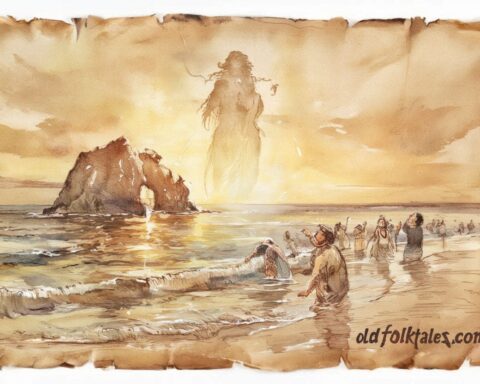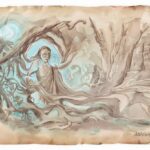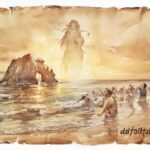Before humankind knew the warmth of the hearth or the glow of the cooking flame, the world was dim and cold. The nights on the island were long, and the people shivered beneath the stars. They ate their food raw and huddled together for warmth. In those ancient days, fire belonged only to the spirits who lived beyond the reach of mortals.
The spirits guarded fire jealously, for they understood its power. To them, fire was life itself, the energy that shaped both creation and destruction. They used it to light their sacred gatherings and to cook the food of the gods. The people, however, were forbidden to approach the sacred flames. They were told that if humans ever possessed fire, they would become too bold and forget their place in the world.
But one day, a clever creature changed everything. Some say it was a monitor lizard; others claim it was the Ko’ko bird, the swift and secretive rail that still roams the jungles of Guam. Whatever the creature’s form, it had watched the spirits for a long time. It saw them dancing around the flames, laughing and glowing in their brightness, and it pitied humankind, who shivered and lived in darkness.
“I will bring the people what they need,” the creature whispered to itself. “If the gods will not share their fire, then I shall take it.”
As the sun set, the spirits gathered around their sacred hearth. The flame rose high and golden, twisting like a living thing. When the spirits began to sing, the clever creature crept close. Step by step, it hid in the shadows, silent as the breeze. It waited for the right moment when the spirits’ laughter filled the air and then darted forward.
With a quick motion, the creature snatched a burning stick from the edge of the fire and fled into the night. Sparks fell as it ran, scattering like tiny stars upon the ground. The spirits shouted in fury and gave chase, their eyes blazing brighter than the fire itself.
The chase tore across the island. The creature darted through forests and over streams, its feet barely touching the earth. It leapt across rocks and raced toward the villages where the people slept. But the flame was hot, and soon the creature’s mouth and paws began to burn.
As the spirits drew closer, the creature called out to the heavens. “If this fire is meant for all, let it find its home among humankind!”
With its last strength, the creature flung the burning stick high into the air. It landed near a village, rolling across dry grass. The people awoke to see the strange glow. They gathered around, astonished by its warmth and light.
The spirits arrived too late. Their sacred fire now burned in human hands. They could not reclaim it, for the fire had touched the hearts of mortals. The gods retreated, vowing that humans must forever respect the flame, for it came from the realm of spirits and carried their power.
The people learned to keep the fire alive. They guarded it carefully, passing its flame from one family to another. Elders taught the children never to waste it or use it in anger. They built their cooking pits and sang prayers before each meal, thanking the spirits for the gift that had changed their world.
In time, the fire became a symbol of transformation and courage. It was the light of knowledge that pushed back the darkness of ignorance. It was warmth in the heart of the night and strength in times of fear.
To this day, Chamorro elders tell the story of the creature who stole fire to remind their people that courage and compassion can bring light to others. They say that the crackling sound of a fire is the whisper of the spirits, still speaking to humankind, reminding them that great gifts come with great responsibility.
The legend also teaches that even the smallest being can change the world. The creature who risked everything did not act for power or pride, but love for the people who lived without warmth and hope. That love became the spark that lit humanity’s path.
Now, whenever a fire is lit on the island, the people honor the flame. They never leave it unattended, and they never let it die without purpose. For within its glow lives the memory of courage, the lesson of sacrifice, and the light that connects humanity to the spirits.
Moral Lesson
The legend of the discovery of fire reminds us that true courage lies in sharing what is good and necessary with others. Fire symbolizes wisdom, warmth, and life gifts that must be used with care and respect.
Knowledge Check
1. Who originally possessed fire in the Chamorro legend?
The spirits of the world kept and guarded fire, refusing to share it with humankind.
2. What creature is said to have stolen the fire for humans?
Some versions say it was a monitor lizard, while others say it was the Ko’ko bird.
3. What happened when the spirits tried to reclaim the fire?
They arrived too late, and the fire had already become part of human life.
4. What does the fire symbolize in the story?
Fire represents knowledge, courage, and the responsibility that comes with power.
5. What moral lesson do the Chamorro people learn from this tale?
That even the smallest act of courage can bring light to others and transform the world.
6. Where does this story originate?
It comes from the Chamorro people of Guam in the Mariana Islands.
Source: CHamoru Legends: A Gathering of Stories by Teresita Lourdes Perez (2019), University of Guam Press.
Cultural Origin: Chamorro (Guam, Mariana Islands)












